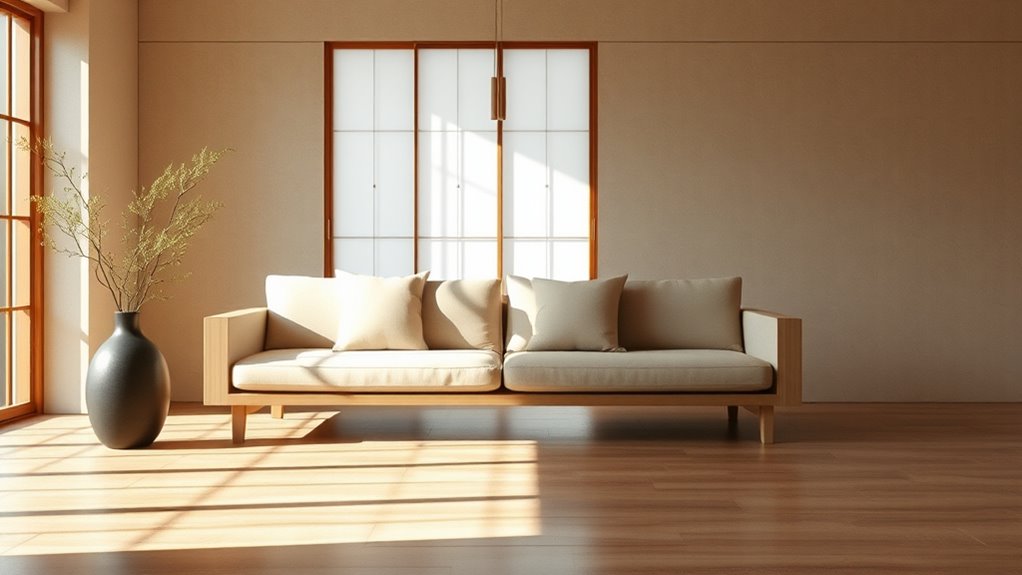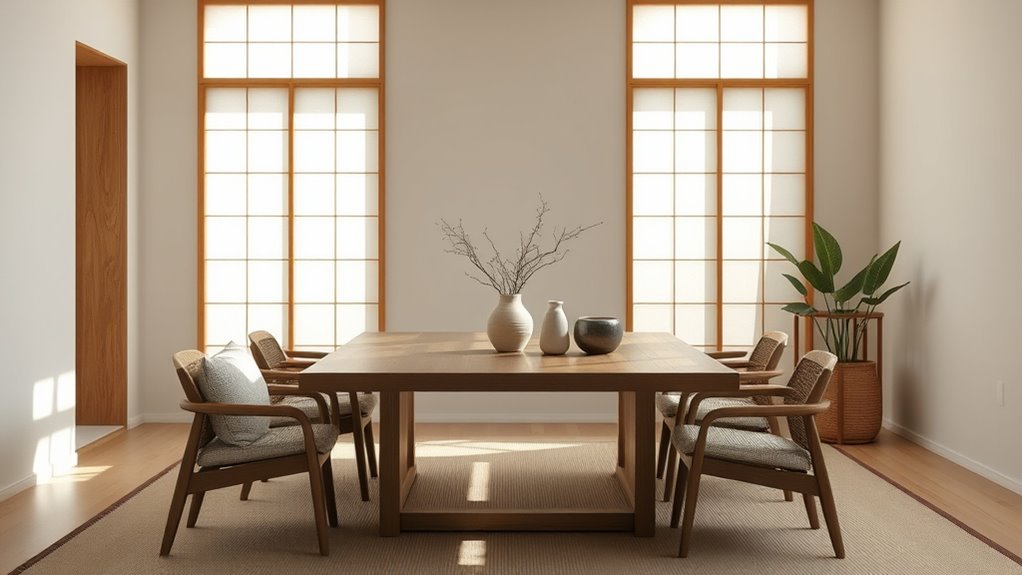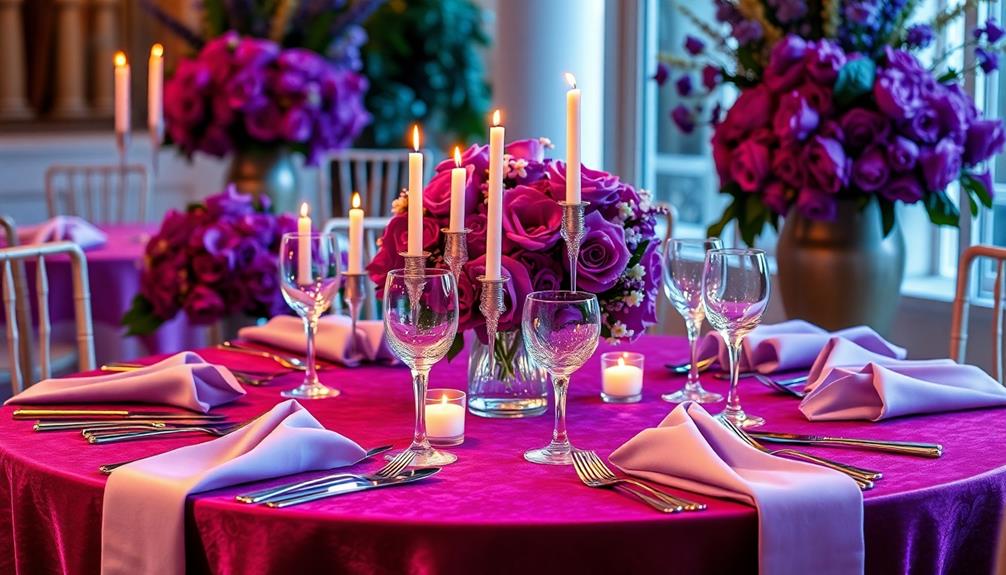Japandi style blends Japanese serenity with Scandinavian minimalism to create calm, functional, and stylish spaces. You’ll notice clean lines, neutral colors, and natural materials like light wood, all emphasizing simplicity and purpose. It’s about balancing minimalism with warmth and craftsmanship, resulting in a tranquil environment free of clutter. If you want to understand how these elements come together for a harmonious look, keep exploring the key features and ideas behind Japandi design.
Key Takeaways
- Japandi style blends Japanese serenity with Scandinavian minimalism for calm, functional spaces.
- It emphasizes simplicity, natural materials, and high-quality craftsmanship with minimal clutter.
- The color palette features neutral tones, warm wood accents, and subtle textures.
- Furniture design highlights clean lines, natural materials, and handcrafted details.
- The overall aesthetic promotes tranquility, mindfulness, and understated sophistication.

Ever wondered how to combine the serenity of Japanese design with the simplicity of Scandinavian aesthetics? That’s the essence of Japandi style, a harmonious blend that balances minimalism with warm, natural elements. At its core, Japandi is about creating a space that feels calm, functional, and aesthetically pleasing without clutter or excess. To achieve this, you need to understand the key principles that underpin both Scandinavian minimalism and Japanese craftsmanship. These elements work together to produce a look that’s understated yet sophisticated, inviting you to unwind and focus on what truly matters.
Japandi blends Japanese serenity with Scandinavian simplicity for a calm, functional, and sophisticated space.
Scandinavian minimalism plays a essential role in Japandi, emphasizing clean lines, neutral color palettes, and uncluttered spaces. You’ll notice that furniture tends to have simple, geometric shapes, often made from light woods like pine or ash. The focus is on functionality, so each piece serves a purpose without unnecessary ornamentation. The color scheme revolves around whites, beiges, and soft grays, which help to create an airy, open atmosphere. This minimalism isn’t cold or stark; it’s warm and inviting because it’s paired with natural materials and textures. Incorporating elements like woven rugs, linen cushions, or ceramic vases adds tactile interest without overwhelming the senses.
On the other hand, Japanese craftsmanship influences Japandi through its dedication to quality, natural materials, and subtle beauty. You’re encouraged to choose furniture and decor that showcase traditional techniques or handcrafted details. This might mean a low-profile wooden table with visible grain, or a hand-thrown ceramic cup with a slightly uneven glaze. The craftsmanship emphasizes authenticity and durability, making each piece feel special and timeless. It’s about appreciating the beauty in imperfection, a concept known as wabi-sabi, which complements the minimalist approach by adding depth and character to your space.
Bringing these two worlds together requires a thoughtful approach. Keep your decor simple, but don’t shy away from high-quality, artisanal pieces that highlight Japanese craftsmanship. Use a restrained color palette, but introduce warm wood tones or subtle textures to add visual interest. The furniture should be sleek but comfortable, with an emphasis on natural materials and craftsmanship. Light plays a essential role, so maximize natural light and use soft, understated lighting to enhance the tranquil vibe. The goal is a balanced space that feels effortless, refined, and calming—an oasis of serenity that reflects the best of both Scandinavian minimalism and Japanese craftsmanship.
Frequently Asked Questions
How Can I Incorporate Japandi Style Into a Small Apartment?
To incorporate Japandi style into your small apartment, focus on minimalist decor and space-saving furniture. Choose furniture with clean lines and simple designs that don’t clutter your space. Opt for neutral colors like beige, soft gray, and warm wood tones to create a calming atmosphere. Keep surfaces clear and add a few natural elements, like plants or woven baskets, to enhance the serene, balanced aesthetic characteristic of Japandi design.
What Are the Best Color Palettes for Japandi Interiors?
Imagine a serene landscape—your space should evoke that calm. For Japandi interiors, opt for soothing color schemes with neutral tones like beige, taupe, and soft greys. These palettes create a tranquil backdrop, highlighting natural materials and minimalist decor. Keep your colors simple and cohesive, letting subtle contrasts and textures add depth. This harmony of muted hues transforms your space into a peaceful retreat, perfectly balancing warmth and serenity.
Is Japandi Suitable for Outdoor Spaces?
Yes, japandi style works well for outdoor spaces. You can incorporate simple, clean-lined garden furniture made of natural materials like wood or rattan, which aligns with japandi’s minimal aesthetic. Add soft outdoor lighting to create a cozy atmosphere and highlight the design’s serenity. Keep the color palette neutral and subdued to maintain harmony with the indoor style, ensuring your outdoor space feels peaceful and inviting.
How Does Japandi Differ From Scandinavian or Japanese Design Alone?
Imagine a serene pond blending two worlds—Japandi differs from Scandinavian or Japanese design by fusing minimalist aesthetics with deep cultural influences from both traditions. While Scandinavian style emphasizes coziness and clean lines, and Japanese design highlights simplicity and natural materials, Japandi harmonizes these elements into a balanced, tranquil space. You get the best of both, creating a unique, elegant look that’s calm yet warm, blending cultural nuances seamlessly.
What Sustainable Materials Are Commonly Used in Japandi Decor?
You’ll find eco-friendly woods like bamboo and reclaimed hardwoods in Japandi decor, emphasizing sustainability. Natural fibers such as linen, jute, and hemp are also common, used in textiles and rugs to add warmth and texture. By choosing these materials, you support eco-conscious living while creating a serene, minimalist space that blends Japanese simplicity with Scandinavian coziness. These sustainable choices help you achieve a stylish, environmentally friendly Japandi aesthetic effortlessly.
Conclusion
Embracing Japandi style is like finding harmony between dawn and dusk—balancing simplicity with warmth. As the gentle ebb and flow of ocean waves bring calm, so does this design blend Scandinavian minimalism with Japanese serenity. You’ll create a space that feels timeless, much like the quiet strength of a mountain or the fleeting beauty of cherry blossoms. In Japandi, you don’t just decorate; you craft a sanctuary where peace quietly resides.









